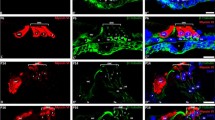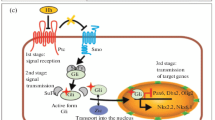Abstract
In situ hybridization experiments carried out with β-tubulin cDNA onXenopus laevis embryos showed a marked increase in β-tubulin mRNA in neural plate and lateral ectoderm after gastrulation, when chordomesoderm and ectoderm come in contact. Experiments with fragments of presumptive neural ectoderm explanted before and after neural induction suggest that the cells are already specified in neural sense at the blastula stage, long before the neural induction.
Riassunto
Ľibridazionein situ condotta su embrioni diXenopus laevis con cDNA di β-tubulina ha dimostrato un forte incremento nelle cellule della piastra neurale e delľectoderma laterale dopo la gastrulazione, quando il cordomesoderma viene a contatto con ľectoderma. Esperimenti condotti su espianti di ectoderma neurale presuntivo eseguiti prima e dopo ľinduzione neurale suggeriscono che le cellule abbiano già un orientamento specifico in senso neurale allo stadio di blastula. prima che ľinduzione avvenga.
Similar content being viewed by others
References
Angerer L. M. andAngerer R. C., 1981.Detection of poly A + RNA in sea urchin eggs and embryos by quantitative in situhybridization. Nucleic Acid Res., 9: 2819–2840.
Banville D. andWilliams J. G., 1985.Developmental changes in the pattern of larval β-globin gene expression in Xenopus laevis. J. molec. Biol., 184: 611–620.
Bergamaschi G., De Bernardi F. eSotgia C., 1988.Localizzazione di mRNA di α-e β-tubulina in embrioni di Xenopus laevis. Rend. Ist. Lombardo Sc. B, 122:107–119.
Cicada Leonardi M., Bolzern A. M., De Bernardi F., Fascio U. andSotgia C., 1987.Microtubules and microfilaments in chick embryo postnodal explants treated with mRNAs. Acta Embryol. Morphol. Exper., 8: 465–471.
Cleveland D. W., Lopata M. A., Mac Donald R. J., Cowan N. J., Rutter W. J. andKirschner M. W., 1980.Number and evolutionary conservation of α- and β-tubulin and cytoplasmic β- and γ-actin genes using specific cloned cDNA probes. Cell, 20: 95–105.
Dale L., Smith J. C. andSlack J. M. W., 1985.Mesoderm induction in Xenopus laevis: a quantitative study using a cell lineage label and tissue-specific antibodies. J. Embryol. exp. Morph., 81: 37–47.
Dawid I. B. andSargent T. D., 1988. Xenopus laevisin developmental and molecular biology. Science, 240: 1443–1448.
De Bernardi F., 1982.Polyadenylated mRNAs from various developmental stages of Xenopus laevis. Role of 26S mRNA. Expl. Cell. Biol., 50: 281–290.
De Bernardi F. andCondorelli L., 1987.Synthesis of tubulin mRNA in different regions of Xenopus laevis embryo. Acta Embryol. Morphol. Exper., 8: 457–464.
De Bernardi F., Sotgia C., Bolzern A. M., Cigada Leonardi M., Fascio U. andRanzi S., 1986.Cell-shape modification induced by exogenous mRNA in postnodal expiants of chick embryo blastoderm. In:H. C. Slavkin (ed.),Progress in Developmental Biology. Part. A, Alan R. Liss, New York: 331–334.
Dworkin-Rastl E., Kelley D. B. andDworkin M. B., 1986.Localization of specific mRNA sequences in Xenopus laevisembryos by in situhybridization. J. Embryol. exp. Morph., 91: 153–168.
Edelman G. M., 1984.Cell adhesion and the molecular processes of morphogenesis. Ann. Rev. Neurosci., 7: 339–377.
Good P. J., Richter K. andDawid I., 1989.The sequence of a nervous system-specific, class II β-tubulin gene from Xenopus laevis. Nucl. Ac. Res., 17: 8000.
Gurdon J. B., 1987.Embryonic induction — molecular prospects. Development, 99: 285–306.
Gurdon J. B., 1989.The localization of an inductive response. Development, 105: 27–33.
Gurdon J. B., Fairman S., Mohun T. J. andBrennan S., 1985.Activation of muscle-specific actin genes in Xenopus development by an induction between animal and vegetal cells of a blastula. Cell, 41: 913–922.
Havercroft J. C. andCleveland D. W., 1984.Programmed expression of β-tubulin genes during development and differentiation of the chicken. J. Cell Biol., 99: 1927–1935.
Herrmann H., Fouquet B. andFranke W. W., 1989.Expression of intermediate filament proteins during development of Xenopus laevis.II. Identification and molecular characterization of desmin. Development, 105: 299–307.
Hopwood N. D., Pluck A. andGurdon J. B., 1989.MyoD expression in the forming somites is an early response mesoderm induction in Xenopusembryos. EMBO J., 8: 3409–3417.
Jacobson M. andRutishauser U., 1986.Induction of neural cell adhesion molecule (N-CAM) in Xenopus embryos. Devl. Biol., 116: 524–531.
Jamrich M., Mahon K. A., Gavis E. R. andGall J. G., 1984.Histone RNA in amphibian oocytes visualized by in situhybridization to methacrylate-embedded tissue sections. EMBO J., 3: 1939–1943.
Karfunkel P., 1974.The mechanism of neural tube formation. Int. Rev. Cytology, 38: 245–271.
Keller R. E., 1975.Vital dye mapping of the gastrula and neurula of Xenopus laevis. I. Prospective areas and morphogenetic movements of the superficial layer. Devl. Biol., 42: 222–241.
Kintner C. R. andMelton D. A., 1987.Expression of Xenopus N-CAM RNA in ectoderm is an early response to neural induction. Development, 99: 311–325.
London C., Akers R. andPhillips C., 1988.Expression of Epi 1,an epidermids-specific marker in Xenopus laevisembryos, is specified prior to gastrulation. Devl. Biol., 129: 380–389.
Lopata M. A., Havercroft J. C., Chow L. T. andCleveland D. W., 1983.Four unique genes required for β-tubulin expression in Vertebrates. Cell, 32: 713–724.
Maniatis T.,Fritsch E. F. andSambrook J., 1982.Molecular cloning. Cold Spring Harbor Lab., 545 pp.
Mohun T. J., Brennan S., Dathan N., Fairman S. andGurdon J. B., 1984.Cell type specific activation of actin genes in the early amphibian embryo. Nature, 311: 716–721.
Nieuwkoop P. D. andFaber J., 1956.Normal table of Xenopus laevis(Daudin). North-Holland Publ. Co., Amsterdam.
Richter K., Grunz H. andDawid I. B., 1988.Gene expression in the embryonic nervous system of Xenopus laevis. Proc. Natl. Acad. Sci. USA, 85: 8090.
Sharpe C. R., Fritz A., De Robertis E. M. andGurdon J. B., 1987.A homeobox-containing marker of posterior neural differentiation shows the importance of predetermination in neural induction. Cell, 50: 749–758.
Sharpe C. R., Pluck A. andGurdon J. B., 1989.XIF3, a Xenopus peripherin gene, requires an inductive signal for enhanced expression in anterior neural tissues. Development, 107: 701–714.
Slack J. M. W., 1983.From egg to embryo. Cambridge Univ. Press, 241 pp.
Slack J. M. W., Darlington B. G., Heath J. K. andGodsave S. F., 1987.Mesoderm induction in early Xenopusembryos by heparin-binding growth factors. Nature, 326: 197–200.
Spemann H. undMangold H., 1924.Über Induktion von Embryonalanlagen durch Implantation artfremder Organisatoren. Arch. mikrosk. Anat. Entw Mech., 100: 599–638.
Sulllvan K. F., 1988.Structure and utilization of tubulin isotypes. Ann. Rev. Cell Biol., 4: 687–716.
Sullivan K. F. andCleveland D. W., 1986.Identification of conserved isotype-defining variable region sequences for four vertebrate β-tubulin polypeptide classes. Proc. Natl. Acad. Sci. USA, 83: 4327–4331.
Sullivan K. F., Lau J. T. Y. andCleveland D. W., 1985.Apparent gene conversion between β-tubulin genes yields multiple regulatory pathways for a single β-tubulin polypeptide isotype. Mol. Cell. Biol., 5: 2454–2465.
Valenzuela P., Quiroga M., Zaldivar J., Rutter W. J., Kirschner M. W. andCleveland D. W., 1981.Nucleotide and corresponding amino acid sequences encoded by α and β-tubulin mRNAs. Nature, 289: 650–655.
Author information
Authors and Affiliations
Additional information
Nella seduta del 12 maggio 1990.
Rights and permissions
About this article
Cite this article
Bernardi, F.D., Fascto, U., Sotgia, C. et al. Synthesis of β-tubulin mRNA in neural induction and specification. Rend. Fis. Acc. Lincei 1, 447–458 (1990). https://doi.org/10.1007/BF03001780
Issue Date:
DOI: https://doi.org/10.1007/BF03001780




